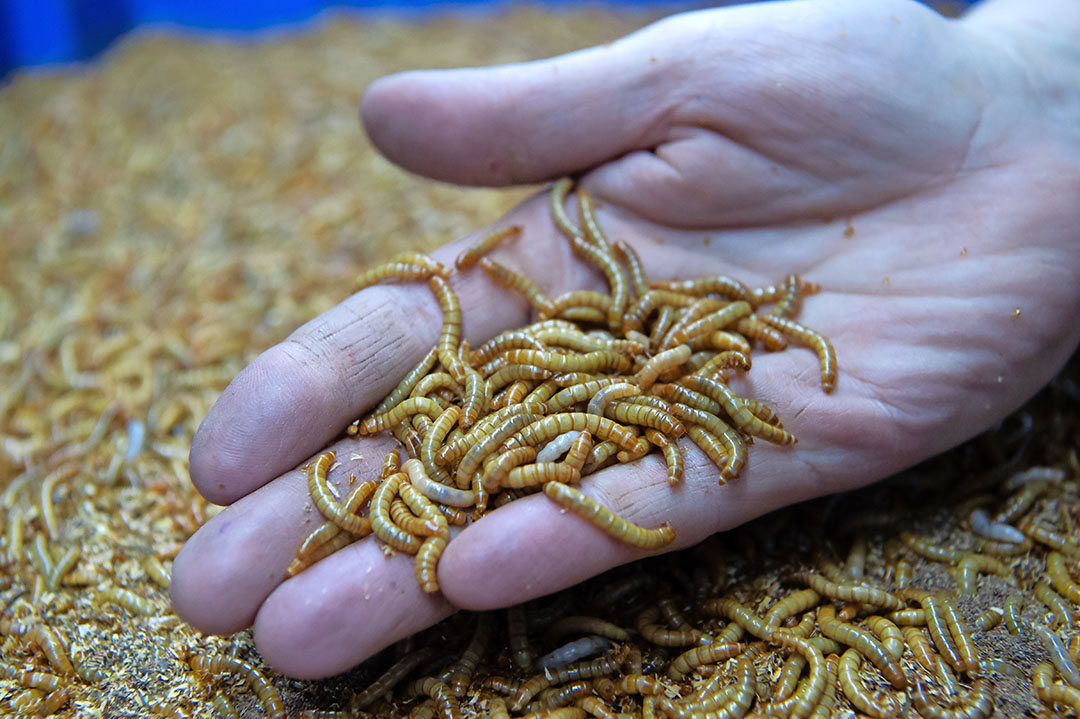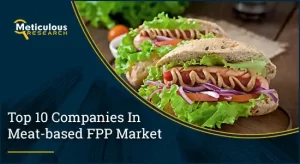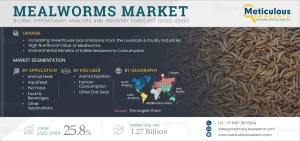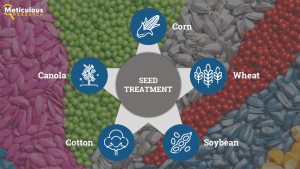
The Mealworms Market is expected to reach $1.27 billion by 2030, at a CAGR of 25.8% during the forecast period 2022–2030. In terms of volume, the mealworms market is expected to grow at a CAGR of 28.6% from 2022–2030 to reach 367,491.7 tons by 2030.
As the global population continues to rise, the demand for sustainable and nutritious food sources has never been more pressing. With a projected increase of 75 million people annually, the world population is expected to reach 9.9 billion by 2050, representing a staggering 33% increase from 2017 levels. This growth necessitates a reevaluation of our current food systems, particularly the livestock industry, which is responsible for a significant portion of greenhouse gas emissions and resource depletion.
Download FREE Brochure of Mealworms Market :- https://www.meticulousresearch.com/download-sample-report/cp_id=5264
The Environmental Footprint of Livestock Production
According to the United Nations Food and Agriculture Organization (FAO), livestock contributes approximately 14.5% of all human-induced greenhouse gas emissions, releasing 7.1 gigatons of CO2 equivalent annually. Notably, the livestock sector consumes around 70% of agricultural land and 30% of the earth’s total land area to meet protein demands. This extensive use of resources has far-reaching environmental consequences.
The land and water footprints of traditional livestock farming are enormous. For example, raising cattle requires vast pastures and significant amounts of water for drinking and feed crops, leading to habitat destruction and depletion of freshwater resources. The production of mealworms, in contrast, requires significantly less energy and resources. The energy needed to produce 1 kg of mealworm protein is lower than that of beef and pork and only slightly higher than chicken and milk. Moreover, mealworms emit substantially less ammonia and greenhouse gases compared to pigs and cattle, making them a more environmentally friendly protein source. For instance, pigs can produce 10 to 100 times more greenhouse gases per kilogram of body weight than mealworms, highlighting the stark differences in environmental impact.
Get Insightful Data On Regions, Market Segments, Customer Landscape, And Top Companies (Charts, Tables, Figures And More) :-https://www.meticulousresearch.com/request-sample-report/cp_id=5264
The Nutritional Profile of Mealworms
Insects, particularly mealworms, are gaining recognition as a high-quality alternative protein source. They are not only rich in protein but also packed with essential micronutrients, such as iron and zinc. In fact, mealworms contain about 50-60% protein by dry weight, comparable to traditional protein sources. This rich nutritional profile makes them an ideal candidate for addressing global protein shortages.
The incorporation of mealworms into our diets also aligns with health trends that emphasize the consumption of nutrient-dense foods. As people become more health-conscious, the demand for alternative protein sources that are not only sustainable but also nutritious is on the rise. Mealworms can provide the essential nutrients required for a balanced diet, particularly in regions where access to traditional sources of protein is limited.
The Case for Mealworms as a Sustainable Protein Source
The environmental benefits of mealworm farming are significant. By rearing mealworms, we can expect a substantial reduction in greenhouse gas emissions, water pollution, and land use impacts. Mealworms require less feed, land, and water while producing fewer greenhouse gases compared to traditional livestock. Specifically, studies have shown that mealworms can convert feed into protein at a much higher efficiency than cattle or pigs. This efficiency is crucial for meeting the protein demands of a growing global population while minimizing environmental degradation.
Furthermore, mealworm meal can replace expensive ingredients, such as soybeans and fishmeal, in animal feed applications, potentially lowering the costs associated with livestock products. This transition could lead to more affordable animal products for consumers, while also reducing the pressure on agricultural land used for growing traditional feed crops.
Another significant advantage of mealworm farming is its ability to recycle waste. Mealworms can thrive on food scraps and animal manure, allowing for the conversion of waste materials into high-quality protein. This not only increases the world’s protein supply but also addresses the issue of food waste, which is a major concern globally. According to the Food and Agriculture Organization, approximately one-third of all food produced for human consumption is wasted each year. By utilizing food waste in mealworm production, we can contribute to a more circular economy and sustainable food systems.
Market Potential and Future Outlook
The demand for mealworms and mealworm-based products is on the rise, driven by their potential to address the challenges posed by traditional meat production. A Dutch study highlights that mealworm protein generates about half as many greenhouse gas emissions as milk, pork, or chicken protein and only a tenth of that from beef. This presents a compelling case for policymakers and consumers to consider mealworms as a viable alternative protein source.
The Mealworms Market is witnessing rapid growth, reflecting a shift in consumer preferences towards sustainable food sources. According to Meticulous Research®, the mealworm market is projected to reach $1.27 billion by 2030, growing at a compound annual growth rate (CAGR) of 25.8% from 2022 to 2030. In terms of volume, the market is expected to expand at a CAGR of 28.6%, reaching approximately 367,491.7 tons by 2030.
This growth presents numerous opportunities for entrepreneurs and investors looking to tap into the alternative protein market. The rise of plant-based diets and increasing awareness of sustainability issues are driving interest in mealworms, creating a burgeoning sector ripe for innovation and investment. Companies that specialize in mealworm production, processing, and product development are well-positioned to capture a share of this growing market.
Scope of the Report:
Mealworms Market, by Product Type
- Whole Mealworm
- Mealworm Meal
- Mealworm Powder
- Other Mealworm Products
Mealworms Market, by Application
- Animal Feed
- Aquafeed
- Pet Food
- Food & Beverages
- Other Applications
Mealworms Market, by End Use
- Animal Nutrition
- Human Consumption
- Other End Uses
Immediate Delivery Available | BUY THIS RESEARCH REPORT (Insights, Charts, Tables, Figures and More) –https://www.meticulousresearch.com/Checkout/74058310
Challenges and Considerations
Despite the numerous benefits, there are still challenges to be addressed in the widespread adoption of mealworms as a protein source. Consumer acceptance remains a significant hurdle, as many individuals are not familiar with insects as food. Educational campaigns and marketing efforts will be crucial in shifting public perception and promoting the nutritional and environmental advantages of mealworms.
Regulatory frameworks also need to be established to ensure food safety and quality standards for insect-based products. As the mealworm industry evolves, policymakers must consider appropriate regulations to govern production practices and labeling to build consumer trust and facilitate market growth.
Related Reports:-
Edible Insects Market Size, Share, Forecast, & Trends Analysis by Product (Whole Insect, Insect Powder, Insect Meal, Insect Oil), Insect Type (Crickets, Black Soldier Fly, Mealworms), Application (Animal Feed, Protein Bar & Shakes, Bakery, Confectionery, Beverages), and Geography – Global Forecast to 2033
South East Asia Edible Insect Market by Product (Whole Insect, Insect Powder, Insect Meal), Insect Type (Crickets, Black Soldier Fly, Mealworms, Ants), Application (Animal Feed, Protein Bar & Shakes, Bakery, Confectionery), and Country – Forecast to 2030
Europe Edible Insects Market by Product (Insect Powder, Insect Meal, Insect Oil), Insect Type (Crickets, Black Soldier Fly, Mealworms, Ants, Grasshoppers), Application (Animal Feed, Pet Food, Protein Bar & Shakes, Bakery, Confectionery) – Forecast to 2030
Contact US:
Meticulous Market Research Pvt. Ltd.
1267 Willis St, Ste 200 Redding,California, 96001, U.S.
USA: +1-646-781-8004
Europe: +44-203-868-8738
APAC: +91 744-7780008
Email– sales@meticulousresearch.com
Visit Our Website: https://www.meticulousresearch.com/
Connect with us on LinkedIn- https://www.linkedin.com/company/meticulous-research
Meticulousblog.org | Top Market Research Reports Blog – https://meticulousblog.org/







